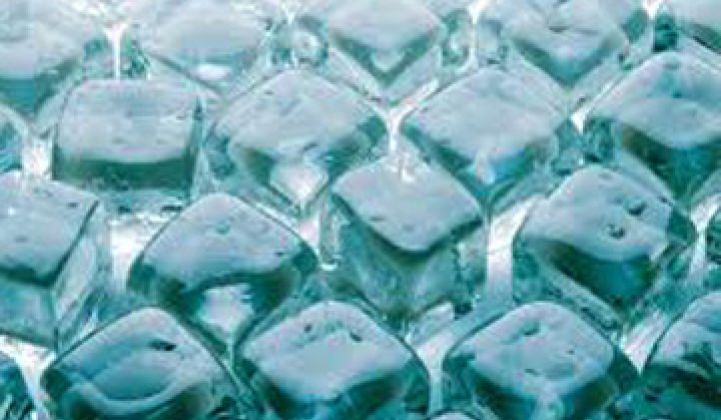Ice Energy of Windsor, Colorado, a provider of distributed ice-based energy storage to electric utilities, completed a $24 million first closing of its Round C with venture financing from TIAA-CREF, Energy Capital Partners, Good Energies, Sail Ventures and Second Avenue Partners. I spoke with Joe Desmond, the Executive Vice President of Ice Energy this morning and he informed me that it was an upround with two new investors.
Energy storage is arguably considered crucial for improving energy efficiency, maximizing the value of intermittent wind and solar generation, and meeting rising peak electrical demand. Ice Energy’s distributed energy storage solution lets utilities use more efficient, less expensive off-peak power to produce and store energy for use during periods of peak demand.
Ice Energy's 53-megawatt project currently underway with the Southern California Public Power Authority is the largest of its kind in the industry.
The firm's ice-based energy storage at commercial buildings has the potential to shift as much as 40 percent of peak energy demand to off-peak hours. When deployed at scale, this represents a new asset-based, sustainable energy resource equivalent to thousands of megawatts of clean peaking power for utilities.
Ice Energy has transitioned its message from being an air conditioning company to more of an energy storage and demand response firm.
Michael Kanellos reported on the company's Southern California Project at the beginning of this year. Here are some excerpts from his article which includes references to Edward Gibbon and the worst Roman Emperor ever:
The Southern California Public Power Authority and Ice Energy are deploying ice air conditioners on a broad scale in the region in part by shifting the burden of paying for a new air conditioner from the building owner to a utility. In one community in the program, a utility will pay for the air conditioners and own them as its own asset.
Collectively, the air conditioners slated for deployment in Southern California could lead to 53 megawatts worth of energy storage. Put another way, the air conditioner/energy storage units could provide 64 gigawatt hours of daytime power each year. Fifty megawatts of power can be shaved from daytime demand with about 5,500 of the company's Ice Bear units, executives have said.
Ice air conditioners work by shifting the power required to run air conditioners from the middle of the afternoon, when power costs the most and demand is highest, to nighttime, when utilities often have to dump the power they generate because of slack demand.
In short, the machines make ice at night. As it melts, the chill is transferred to heat exchangers and distributed through a building. The six hours of chill the ice can provide can ideally get most buildings though the bulk of the day. The giant icemakers often sit beneath parking lots.
Ice air conditioners have been around since the 1920s, when movie theaters used to deploy them to draw crowds on hot summer days. (And long before that, Roman Emperor Varius Avitus had snow mounds brought to his garden to generate cool breezes. (It was a highlight of his reign -- Edward Gibbon and others rank him as the worst emperor Rome ever had.) In more recent times, ice air conditioners have been placed in shopping centers and university buildings.
Still, ice air conditioners represent only a fraction of the market. Ice Energy has been pushing to accelerate sales by changing incentives and ownership structures. The company used to sell the systems directly to building owners. Unfortunately, payback can take years, if it ever takes place at all. Some ice air conditioners actually use more power than regular air conditioners: unless a building owner participates in a net metering program, they could end up being worse off.
Utilities, however, consistently benefit from them because of the reduction in peak power demand they can create. Air conditioners can account for as much as 50 percent of electricity consumption in California, and even more in hotter places like Dubai. As a result, Ice Energy shifted strategies and began to sell its units to utilities as devices for peak shaving. In this light, the ice air conditioners function like demand response systems, eliminating a chunk of daytime power needs, without the networking. It just happens on a daily basis.
Three U.S. representatives last year proposed a bill that would provide business owners and consumers a 30 percent tax credit for installing ice systems as well, which would help spur demand in places where utility-based programs don't exist. It could also help defray costs for the utility.
Calmac, which also makes ice air conditioners, recently installed a giant system in New York's Bank of America building.
***
Greentech Media has written as much as any news source or analyst house on the technology and politics of utility-scale energy storage. Here is just a fraction of our reporting and analysis:
- A massive energy storage project using sodium sulfur (NaS) batteries
- Energy Storage Medley: Hydrogen, CAES, Li-ion, NaS, NiCad…
- Energy Storage Needs Better Utility Policy, Language, Culture to Succeed
- Gravel-based thermal storage from Isentropic Energy -- Thermal Energy Storage Breakthrough?
- Compressed Air Energy Storage (CAES) part 1, part 2, part 3
- Ultracapacitors -- Maxwell and the Promise of Ultracapacitors
- Xcel Shows it Can Catch Wind in a Big Battery



